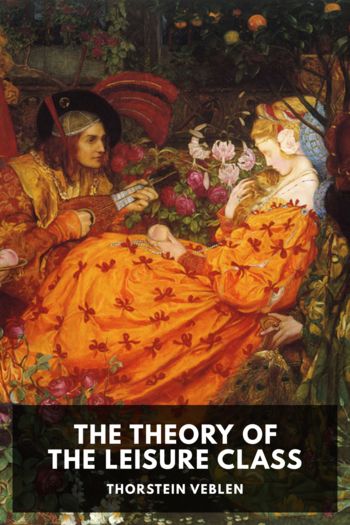The Theory of the Leisure Class by Thorstein Veblen (phonics readers TXT) 📕

- Author: Thorstein Veblen
Book online «The Theory of the Leisure Class by Thorstein Veblen (phonics readers TXT) 📕». Author Thorstein Veblen
As regards the wealthier class of the North, the American leisure class in the best sense of the term, it is, to begin with, scarcely possible to speak of an hereditary devotional attitude. This class is of too recent growth to be possessed of a well-formed transmitted habit in this respect, or even of a special homegrown tradition. Still, it may be noted in passing that there is a perceptible tendency among this class to give in at least a nominal, and apparently something of a real, adherence to some one of the accredited creeds. Also, weddings, funerals, and the like honorific events among this class are pretty uniformly solemnized with some especial degree of religious circumstance. It is impossible to say how far this adherence to a creed is a bona fide reversion to a devout habit of mind, and how far it is to be classed as a case of protective mimicry assumed for the purpose of an outward assimilation to canons of reputability borrowed from foreign ideals. Something of a substantial devotional propensity seems to be present, to judge especially by the somewhat peculiar degree of ritualistic observance which is in process of development in the upper-class cults. There is a tendency perceptible among the upper-class worshippers to affiliate themselves with those cults which lay relatively great stress on ceremonial and on the spectacular accessories of worship; and in the churches in which an upper-class membership predominates, there is at the same time a tendency to accentuate the ritualistic, at the cost of the intellectual features in the service and in the apparatus of the devout observances. This holds true even where the church in question belongs to a denomination with a relatively slight general development of ritual and paraphernalia. This peculiar development of the ritualistic element is no doubt due in part to a predilection for conspicuously wasteful spectacles, but it probably also in part indicates something of the devotional attitude of the worshippers. So far as the latter is true, it indicates a relatively archaic form of the devotional habit. The predominance of spectacular effects in devout observances is noticeable in all devout communities at a relatively primitive stage of culture and with a slight intellectual development. It is especially characteristic of the barbarian culture. Here there is pretty uniformly present in the devout observances a direct appeal to the emotions through all the avenues of sense. And a tendency to return to this naive, sensational method of appeal is unmistakable in the upper-class churches of today. It is perceptible in a less degree in the cults which claim the allegiance of the lower leisure class and of the middle classes. There is a reversion to the use of colored lights and brilliant spectacles, a freer use of symbols, orchestral music and incense, and one may even detect in “processionals” and “recessionals” and in richly varied genuflectional evolutions, an incipient reversion to so antique an accessory of worship as the sacred dance. This reversion to spectacular observances is not confined to the upper-class cults, although it finds its best exemplification and its highest accentuation in the higher pecuniary and social altitudes. The cults of the lower-class devout portion of the community, such as the Southern Negroes and the backward foreign elements of the population, of course also show a strong inclination to ritual, symbolism, and spectacular effects; as might be expected from the antecedents and the cultural level of those classes. With these classes the prevalence of ritual and anthropomorphism are not so much a matter of reversion as of continued development out of the past. But the use of ritual and related features of devotion are also spreading in other directions. In the early days of the American community the prevailing denominations started out with a ritual and paraphernalia of an austere simplicity; but it is a matter familiar to everyone that in the course of time these denominations have, in a varying degree, adopted much of the spectacular elements which they once renounced. In a general way, this development has gone hand in hand with the growth of the wealth and the ease of life of the worshippers and has reached its fullest expression among those classes which grade highest in wealth and repute.
The causes to which this pecuniary stratification of devoutness is due have already been indicated in a general way in speaking of class differences in habits of thought. Class differences as regards devoutness are but a special expression of a generic fact. The lax allegiance of the lower middle class, or what may broadly be called the failure of filial piety among this class, is chiefly perceptible among the town populations engaged in





Comments (0)